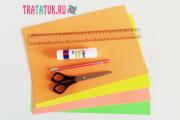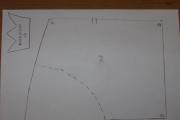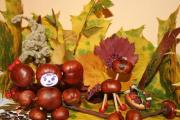Do-it-yourself heating pad for a teapot - master classes and tips on sewing a woman. Do-it-yourself heating pad for a teapot - we invite you to a fragrant tea party A heating pad for a teapot made of pentagons
A nice little thing - a hand-sewn heating pad for the teapot. It’s interesting that even if a family often uses tea bags when running, the housewife almost always has a heating pad in the kitchen. This is not just a tradition or a tribute to fashion - this is the style of Russian tea drinking.
How to sew a chicken warmer for a teapot?
To make a chicken warmer, we will need several pieces of fabric, thread, organza braid, filler and other little things.
1. Place the pattern of the heating pad parts on several sheets of paper. On this piece of paper we draw the details of the front part of the heating pad and the comb.

2. At the next stage we draw the details of the back of the heating pad, the beak and the heart.


4. Cut out the patterns and connect the parts of the heating pad according to the marked letters.

5. Let's start transferring the patterns onto the fabric. For the beak and scallop, we fold the red fabric in two layers.

6. Lay out the pattern on the fabric and secure it with pins. Using a pencil, transfer the outline of the patterns onto the fabric.

7. We machine stitch along the marked lines, after which we cut out the comb and beak with small allowances.

8. Using a plastic stick, turn the parts right side out.

9. Fill the comb and beak with filler so that the parts take shape, but are not too dense.

10. We sweep the edges of the parts with hand stitches, the comb and beard are already ready.

11. We proceed to transferring the pattern of the chicken itself. Fold the fabric for the heating pad in two layers.

12. We connect the patterns according to the marks and place them on the fabric. We outline the main contour of the heating pad with chalk.

13. Cut out the main part of the chicken, cut out the parts with scissors, leaving a small allowance.

14. On the front of the heating pad, the collar of the chicken is outlined in dotted lines. Cut it along the line. For the collar, choose gray fabric. Using chalk, transfer the outline of the pattern onto the fabric.

15. Now we cut out the blank for the collar.

16. Using cardboard paper according to the pattern, we will make a template for the collar. Using a pencil, transfer the collar onto the cardboard.

17. Now we cut out the pattern.

18. Place a pattern on the collar piece. The pointer shows the cut that we will iron according to the pattern. From the wrong side, using an iron along the pattern, iron the rounded section of the chicken collar.

19. Under the pressed hem of the collar we pin up an organza ruffle.

20. On the front side, we adjust the collar at the same time as the trim.

21. Pin the beak and comb into the upper corners of the heating pad. Let's baste them.

22. Now we machine stitch it in place. We remove the basting.

23. The heating pad for the kettle should keep it warm. Therefore, we will place insulation between the layers of the lining. We cut out rectangles from fabric in two layers, making the size of the segments slightly larger than the parts of the heating pad.

24. Place the filler on one of the layers of the lining. Cover the filling with another layer of fabric on top.

25. We fasten two layers of fabric together with pins. We machine stitch along the edges and in the middle.

26. Trim the edges and get an insulated lining for the chicken.

27. Place the heating pad parts on the prepared lining. We pin them with pins. We cut the lining along the top part.

28. In the other upper corner we secure a twine tail with pins. We twist the twine into rings.

29. Sew the tail with a machine stitch.

30. Place the parts of the heating pad together with right sides facing inward. We fasten the parts along the top and side edges with pins.

31. Separately fold and pin the lining pieces together, facing inward. On one side seam of the lining we leave an area unstitched.

32. Turn the top of the heating pad right side out.

33. We put it in the lining.

34. Along the lower edges, we pin the lining and the top of the heating pad together with pins.

35. Lay out the parts of the lining and top of the heating pad in different directions. Through the hole left in the side of the lining, turn the heating pad right side out.

36. We pin the hole with pins. We sew the area with machine stitching.


38. We sew the bottom of the heating pad with hand oblique stitches. We lay a finishing stitch according to the basting.

39. Sew on the eyes using black beads.

40. Cut out hearts from gray fabric folded in two layers. Using a pencil, draw the outline of the pattern.

41. Pin the ends of the braid to the top of the heart.

42. Place other heart details on top. We fasten the parts with pins. We bring the braid into areas that we will leave unstitched. We machine stitch along the marked lines.

43. Turn the hearts right side out and at the same time pull out the braid. Fill the hearts with padding polyester.

44. Sew braid with hearts onto the back of the hen-warmer. We tie a ribbon bow on the back.

45. Our chicken is ready, let's start sewing napkins. Using the cut piece, we cut out the lining for the bottom. It should be slightly larger than the main part.

46. We combine all the cuts with each other, the upper part should be smaller than the lower one, the seams still need to be aligned. We machine stitch the parts. Leave room for turning right side out.
47. Turn the warmer napkin inside out and sew a piping onto the top of the napkin. Iron the napkin and pin the tape onto the seam. We sew it with a machine stitch along the top. We tie the ends of the braid into a bow.

48. The napkin is ready. It is used under the bottom of the chicken warmer.

49. Now your favorite kitchen has a new piece of furniture that retains the warmth of tea and the coziness of the hearth.

The tradition of inviting friends for a cup of tea has existed for a long time. There are people for whom it is completely normal to drink an infusion of something from a bag while running, but true connoisseurs of the drink assure: only a leaf brewed according to all the rules can give real pleasure. To keep warm, you need not a banal towel, but a heating pad for the kettle. Making a pattern, sewing it and decorating it with your own hands is not at all difficult.
 The easiest option to implement. But this does not mean at all that it should be anything - a few decorative elements will turn the craft into an interesting accessory for the kitchen. You can make a heating pad for a teapot with your own hands; the master class will help even beginners cope with this task.
The easiest option to implement. But this does not mean at all that it should be anything - a few decorative elements will turn the craft into an interesting accessory for the kitchen. You can make a heating pad for a teapot with your own hands; the master class will help even beginners cope with this task.
If the heating pad completely covers the teapot, in this case you can do without a complex pattern. It is better to make the inner surface of the cap from cotton fabric; the insulating material can be padding polyester, batting or even felt - the main thing is that it provides thermal insulation. The outer layer can be anything, it all depends on the desire of the author and his creative intent.
By wrapping a sheet of paper around the teapot, you can determine the width of the fabric cut. Now you need to set the height, for which you need to connect the paper from the side of the spout and from the side of the handle.
The resulting rectangle will be the size for the inner layers of the cap. The outer cut is made a little larger: the fabric should not “stick” to the insulation and squeeze it. All layers need to be cut out with seam allowances on four sides; a centimeter or one and a half will be enough. After this, you can begin assembling the parts:
- First, you need to lay insulation on the cotton fabric (face down), fold it 1 cm and sew the bottom edge.
- Fold the top 2 cm and also stitch it, putting the lace inside in advance.
- Now it's time for the side seam. The main thing is not to sew the lace, because they need to tighten the top of the bell as much as possible. The base of the heating pad is ready.
How to decorate the outer part of the cap is up to the author of the work: decorate it with embroidery, beads, appliqué or drapery. Or you can take a waffle towel with a pattern you like or use the patchwork technique. The outer “clothes” of the heating pad can be either removable or sewn to the bell. The assembly principle is the same, but the laces of the base and front layer must be tied so that the fabric does not move during use, and a loop must be sewn into the “top” of the heating pad for convenience.
If there are scraps of fabric left over from the fabric used for the outside, it will be very useful to make a few placemats for cups.
Sewing a heating pad for a chicken-shaped teapot is not as difficult as it might seem. Having prepared the fabric for the inner and outer layers, insulation (batting, padding polyester), threads, scissors, sewing machine and needle, you can start working:

Many people call the teapot warmer another name - Dunyasha. A do-it-yourself teapot doll made from patterns that were used back in Tsarist Russia to create a samovar babka exudes coziness and warmth. The difference, perhaps, is only in the selection of materials. As for the doll itself, there are many options:
- Russian beauty with a porcelain face;
- funny tilde;
- chubby rag toy.
The top of an old but in good condition plastic doll will also work. The working part of the product is a skirt, which is made according to the principle of a cap. Dimensions for the pattern of a life-size teapot doll are made using paper wrapped around the teapot.
If the top fabric along the bottom edge is not connected to the insulation and the inner layer, you should first make the functional part: spread the insulation between two rectangles of cotton fabric and quilt it. The resulting blank measures 29x74 cm and will become a heat-insulating bell after the side, bottom and top seams are stitched. Using an elastic band in the drawstring, tighten the base.
Darling Dunyasha
 To make a head for a samovar woman, it is better to take a beige, but you can also use a white, square with sides of 29 cm. You need to put a lump of filler (cotton wool, padding polyester) in the center, wrap it in cloth and tightly wrap the “neck” with a strong thread. Now you need to securely fix the head by sewing it to a heat-insulating bell, sewn from rectangular blanks measuring 55x23 cm.
To make a head for a samovar woman, it is better to take a beige, but you can also use a white, square with sides of 29 cm. You need to put a lump of filler (cotton wool, padding polyester) in the center, wrap it in cloth and tightly wrap the “neck” with a strong thread. Now you need to securely fix the head by sewing it to a heat-insulating bell, sewn from rectangular blanks measuring 55x23 cm.
The removable upper skirt can be designed in an ethnic style, but it is quite acceptable to create a fantasy costume in accordance with the external characteristics of the selected model.
From the same fabric as the skirt, or the same color as the scarf tied on the head, you need to sew sleeves - a tube 20 cm long, fill it loosely with holofiber or padding polyester, and sew up the edges. The central part of the workpiece is attached to the head and skirt, the ends are also fastened with several stitches to the base.
The heating pad is ready, it can be used as a talisman, that is, without certain facial features. But if you wish, then eyebrows, eyes, nose and mouth can be embroidered or drawn.
 To make a woman for the samovar, in addition to the head and arms created as for Dunyasha, you will need a torso with signs of a portly person. A torso is made from a colored piece of fabric and foam rubber, two cotton balls in fabric covers are sewn on - this will be a magnificent bust. The functional part of the heating pad (heat-insulating dome) must be sewn from rectangular and quilted blanks measuring 58x27 cm. All parts are sewn together with a hidden seam.
To make a woman for the samovar, in addition to the head and arms created as for Dunyasha, you will need a torso with signs of a portly person. A torso is made from a colored piece of fabric and foam rubber, two cotton balls in fabric covers are sewn on - this will be a magnificent bust. The functional part of the heating pad (heat-insulating dome) must be sewn from rectangular and quilted blanks measuring 58x27 cm. All parts are sewn together with a hidden seam.
But you can complicate the task: make a frame for the product from wire. Three pieces of 80 cm each need to be folded in half, and then begin to twist them together into one bundle. After 15 cm, at shoulder level, insert a piece 20 cm long between the segments - these will be the arms. Continue twisting the “torso” to the waist (another 10 centimeters), and then separate the ends according to the principle of spider legs: in different directions and with an arched bend outward.
 The frame must be installed on the base and sewn on top of the dome, and the excess wire must be carefully bent. The torso is also made on a frame and is immediately connected with strong threads to the bell with a hidden seam. For the hands, you can take a ribbon from the remains of padding polyester and wrap it around the frame. The head is placed on a twist and sewn to the body with a hidden seam. To style your hair or braid your hair, you can use floss or woolen threads.
The frame must be installed on the base and sewn on top of the dome, and the excess wire must be carefully bent. The torso is also made on a frame and is immediately connected with strong threads to the bell with a hidden seam. For the hands, you can take a ribbon from the remains of padding polyester and wrap it around the frame. The head is placed on a twist and sewn to the body with a hidden seam. To style your hair or braid your hair, you can use floss or woolen threads.
Now the doll needs to be dressed and decorated. Whatever the author likes will be used: a costume for Maria Ivanovna can even be silk or guipure lined, with beads, embroidery, lace or braid. Here it is important not to lose a sense of proportion and choose the optimal combination of decor and color scheme.
There are a lot of ways to make teapot warmers using different techniques, but this is even good: You can choose the option that you like. Any of these dolls will add coziness to the kitchen and help make a conversation over a cup of friendly tea intimate and unforgettably warm.
Attention, TODAY only!
Drinking tea in the company of friends is always a pleasure. And it’s even better to do this in a kitchen that is decorated with cute accessories. They are very popular now. Of course, you can buy them, but it’s much more interesting to make them yourself. Read the article materials. Start the creative process. You can make an excellent one with your own hands. The master class examines various options for creating this kitchen item.
You can make an accessory of a simple shape with just a couple of seams. The work will take no more than an hour. Having mastered the technology, if you have the desire, patience and free time, you can make a souvenir from several beautiful scraps, as shown in the illustration above, or take any complex sample from the article.
We sew unusual teapot warmers with our own hands
The infuser, just like the one in which you boil water, tends to cool down quickly. They will not be able to provide a long conversation with The situation can be corrected by sewing “clothes” for them. It will serve as a functional item and a decorative element in your kitchen.
If you decide to make a heating pad for the first time and want to do it quickly, use the simplest option - sew the product like a hat with a loop or in the shape of a cylinder.

For those who are looking to create something more impressive, you can use one of the ideas below. A heating pad for a teapot can be made in the form of:
- Tilda dolls, pumpkin heads or using any other technology;
- bird or animal;

- a fruit or vegetable, which is sewn from parts in the form of petals;

- snowman or Christmas tree as New Year's decor.
Felt and fleece souvenirs are also popular and easy to make. These materials do not require edge finishing and can be finished on the outside with a regular overcast or decorative stitch. Small felt elements are easily glued to the base.
Materials and tools
So, you want to make an original heating pad for a teapot with your own hands. Let's start the master class on making this kitchen accessory by studying the list of necessary items that need to be prepared.
Before you begin, purchase or remove from your closet the following:
- multi-colored shreds for a decorative base;
- fabric for lining;
- batting or any other insulation to create a functional layer of the heating pad;
- paper, pencil for creating a pattern (or a printer if you print the template);
- scissors;
- pins, chalk;
- thread and needle;
- sewing machine;
- decorative elements (beads, plastic eyes, lace, sequins, floss, brushes and paints, if you make a doll this way).
In general, nothing special is required. If you do crafts, you probably have everything at home. If not, it's easy to purchase. It's good to find a store that sells fabric by weight. They sell small scraps there. They are just right for you.
Do-it-yourself heating pad for a teapot: master class
Here we will consider the simplest option in the form of a cap. In fact, on its basis you can sew a more complex thing, adding a three-dimensional animal head, paws, tail or doll elements to the base.
If you want to make a heating pad very quickly, you can even take a factory-made towel or napkin and use not only the bright colors, but also the trimmed edge to your advantage.
So, to sew a teapot warmer with your own hands, you will need to take some measurements:
- Take the item for which you are going to make clothes, determine its height.
- Measure the largest width including the spout, if you do not make a hole under it, so you can pour the drink without removing the heating pad.

How to sew an elegant young lady
Charming teapot warmer dolls can be made from all sorts of leftover scraps of fabric. Textile souvenirs and their production are now a fashionable direction in handicrafts. Warmers made in the shape of girls and women dressed in fluffy dresses have always been a traditional kitchen attribute. Previously, they were performed based on Russian folk costume in the form of peasant women and merchant women.

Now Tildas, pumpkin heads or all sorts of characters in the form of modern girls, fairy-tale heroes or even humanoid animals are gaining more and more popularity.

To get such a product, you will need to sew the base using the method from the previous section and separately make the arms, head and connect everything together. A blank in the shape of a heating pad can be immediately made into a dress.
Warmers in the form of vegetables and fruits
You can sew an orange, a tomato, and an apple. The spherical shape can be made from parts in the shape of symmetrical petals, the bottom of which is cut in a straight line.
So, you have seen how to make a heating pad for a teapot with your own hands. The manufacturing master class made it clear that it is simple. Choose any idea. Embody it in the material. Surprise your guests with original jewelry of your own making.
If we remember the traditions of tea drinking in Ancient Rus', many people will immediately recall such cute, original and at the same time funny tips. At that time, homemade attachments in the form of various figures were used, and in cartoons we saw how an ordinary felt boot was used for the same purpose. With the advent of electric kettles and the abandonment of bulky samovars, interest in tea did not disappear, but the truth is that the ceremonies of drinking such a drink are no longer so maintained.
Most often, we drink it on the run, getting ready for work, or, more correctly, in a quiet, cozy environment while relaxing. This is where an accessory that has been forgotten by many (though not for the electric kettle itself, but for the teapot) comes in handy - a do-it-yourself heating pad for the kettle. Patterns can be made easily, sewing is also not a big problem. Such a thing will fit perfectly into the interior, and if you wish, you can make it look like some kind of plant, animal or any other object. Let's consider in detail how to implement such an idea.
Hot water bottle for kettle
In the modern world, any item can be purchased in a store. Kettle warmers are no exception. Such a thing is useful in the household: it helps keep the water in the kettle hot, makes the tea leaves stronger, and is also part of the interior. However, often in the store you don’t find something you like enough to want to buy.
There is a way out of this situation: we take patterns, fabrics and do what you want.
Pattern of a heating pad for a teapot
Schemes and patterns of a heating pad for a teapot with your own hands, found on the Internet, are not always suitable for any specific case. Therefore, this method is not the most correct.
To avoid problems, it’s easier to make the pattern yourself, especially since it’s not that difficult. For this you will need:
- A2 or A3 size paper. Both graph paper, sold in specialized stores, and regular newspaper will do.
- Stationery (pencil, eraser, long ruler).
The first thing you need to do is take measurements of the teapot: width and height, and write these data down on a piece of paper so you don’t forget.
Important! The height is measured from the base to the top of the lid, and the width is measured from the outermost part of the handle to the end of the spout.
- Lay the paper out on the floor or table.
- We set aside the height of the kettle, adding a couple of centimeters of reserve.
- The second number is the width, divide it in half, set the resulting figure perpendicular to the height, not forgetting about the reserve.
- We connect the extreme points with a quarter of a circle. You can change the shape a little to make it more square.
The pattern is ready! All that remains is to cut it out, and you can proceed to the next stage.
Sew a heating pad
The next stage raises the question, how to sew a cover for a teapot with your own hands, having patterns?
For this part of the work you will need:
- Thick fabric for the inside of the heating pad.
- Fabric of your choice for the outside.
- Insulation (preferably synthetic winterizer or cotton wool).
- Elements of decorations, if you want to complement the finished case.
 Next we perform the following steps:
Next we perform the following steps:
- Fold the lightweight fabric in half. We place the pattern on the fold so that when cutting out the piece of fabric, you get a semicircle. There should be two such details.
- Repeat step 1 for thick fabric. As a result, you should get four pieces: two light and two dense.
- We sew light fabric around the circumference without touching the base. We repeat the same for blanks made of thick fabric.
Important! For faster and more durable stitching, you can use a sewing machine.
- We sew the blanks at the base, not forgetting to place insulating filler between the two layers of fabric.
- We bend the bottom part inward a centimeter, smooth it and stitch it.
Important! If desired, you can sew a small loop on top. To decorate a homemade teapot warmer, you can use different fabric items:
- bows, butterflies and other little things that can be bought in sewing stores;
- beads and seed beads;
- embroidery
Ideas for a heating pad
If you want to do something unique, you can change the design a little or even make the case look like an animal, be it a cat, a rooster or a cow.
Hot water bottle cat
To make an ordinary heating pad look like a cat, you need to select a suitable fabric and add several elements, for example, a tail, a head with eyes and a nose, and paws.
It is not at all necessary to sew everything separately: some parts can simply be drawn. It all depends on your imagination.
Hotty cock
How to make a rooster warmer for a teapot with your own hands? It's a little more complicated than making a cat:
- Firstly, the shape of the cover should be slightly elongated and end in a “head”. To this head you need to sew a beak, beard, comb and eyes.
- Secondly, any rooster must have a tail. We make each feather for it separately. We cut out two arcs from a certain color and sew them together, stuffing them with padding polyester. We sew the finished feathers to the part where the rooster should have a tail.
Important! The luxuriance of the tail depends on your desire: it can be voluminous or not exist at all. You can make a tail by simply extending the back of the heating pad a little.
- You can also make wings by simply drawing them or making them out of fabric like a tail.
Hot water bottle cow
It is done almost the same way as a cat. The head should have horns, a nose, eyes and ears. The tail is made from a fairly thick rope, with a tassel at the end. You can sew a loop instead of a tail.














